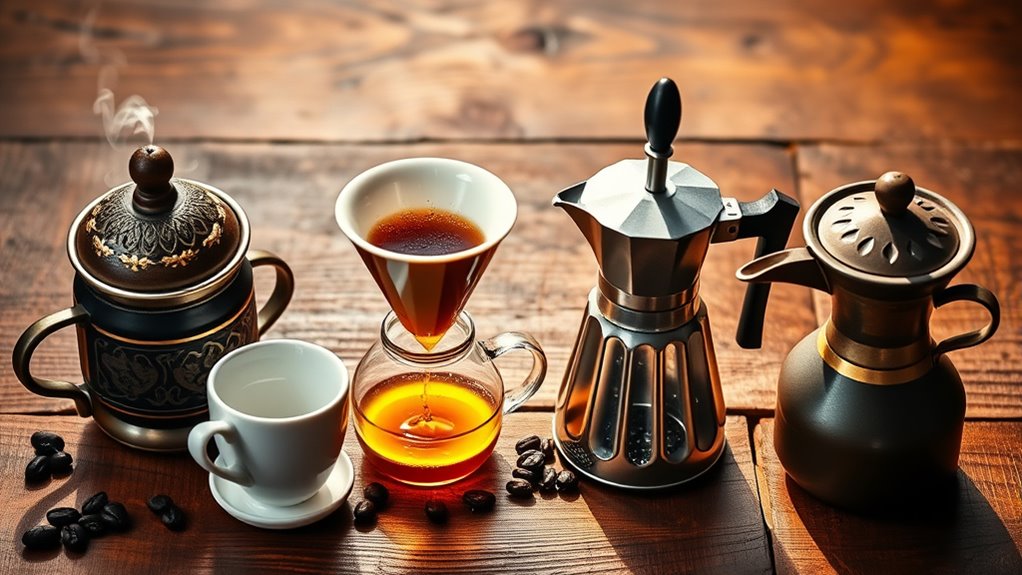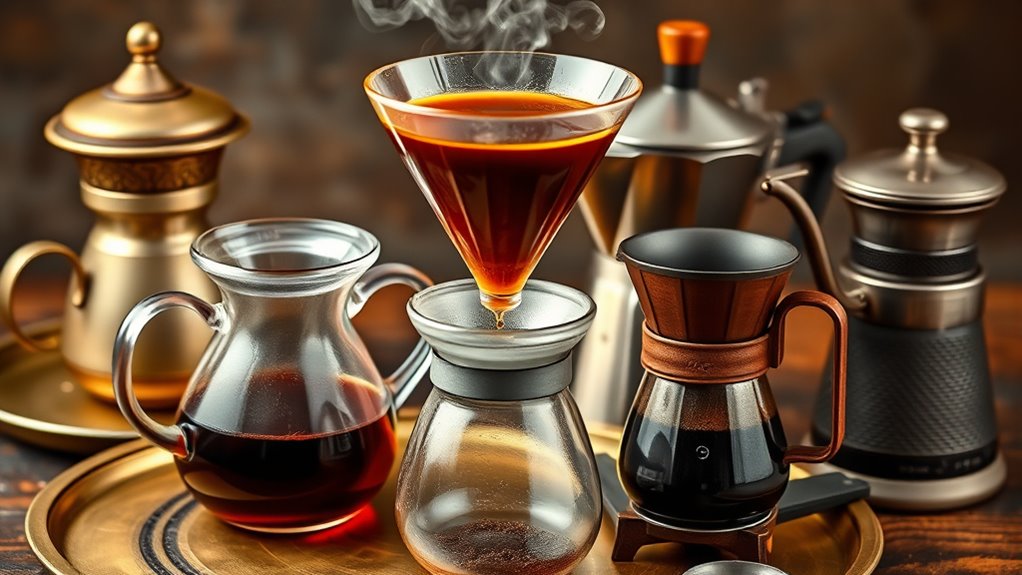Explore the diverse ways countries brew coffee around the world. You might enjoy Turkish coffee, where grounds boil directly in water, or try Middle Eastern cezve for a strong, aromatic cup. Japan’s nel drip uses slow pour-over for clarity, while Indonesia’s Kopi Joss adds smoky flavor via hot metal pipes. Costa Rica’s café chorreador offers smoothness with cloth filters, and French press provides bold richness. Continue exploring to discover even more unique techniques from around the globe.
Key Takeaways
- Regional techniques like Middle Eastern cezve, Turkish coffee, and Indonesian Kopi Joss showcase diverse methods and flavors.
- French press and pour-over methods emphasize control, clarity, and full-bodied richness in brewing.
- Chemex produces a smooth, balanced cup with bright clarity through thick paper filters.
- Espresso machines utilize high pressure for concentrated, intense coffee shots foundational to many global beverages.
- Traditional methods often reflect cultural heritage, using specific tools and techniques unique to each region.

Coffee is a beloved global beverage that showcases a rich variety of brewing methods and cultural traditions. When you explore how different parts of the world prepare coffee, you’ll discover that each region has developed unique techniques reflecting local tastes and customs. Some methods rely on simple tools, while others utilize complex equipment, all contributing to distinct flavor profiles.
Coffee’s global traditions reveal diverse brewing techniques shaped by local tastes and customs.
For example, the Middle Eastern cezve involves heating finely ground coffee in a small pot over a flame or in hot sand, producing a strong, aromatic brew. In Japan, the nel drip method employs a cloth and handle, allowing for a slow, controlled pour-over that emphasizes clarity and subtlety. Indonesia’s Kopi Joss brews coffee in a metal tube filled with hot water, passing the brew through a small pipe, creating a smoky element. Costa Rica’s café chorreador uses a cloth bag to filter the grounds, resulting in a smooth, clean cup that highlights the coffee’s bright notes. Turkish coffee, renowned for its rich and intense flavor, is made by boiling very finely ground coffee directly in water, often served unfiltered, with the grounds settling at the bottom. These regional techniques demonstrate how culture shapes brewing preferences and flavor outcomes.
The French press stands out for its full-immersion approach, where coffee grounds remain submerged in water during the entire brewing process, offering a full-bodied, robust flavor. To achieve the best results, you typically use a coarse grind to prevent clogging, with a brew time of around four to five minutes. The French press is appreciated for its simplicity and ability to produce a rich, sediment-laden cup that emphasizes boldness. Additionally, the materials used, such as glass and stainless steel, contribute to the durability and aesthetic appeal of the device.
Meanwhile, the pour-over method grants you precise control over variables like water temperature and pouring speed. Using cone-shaped filters such as the V60 or Kalita Wave, you can customize the flavor by adjusting grind size and pouring technique. This method produces a clean, crisp coffee ideal for small batches, often highlighting subtle nuances in the beans.
Chemex brewing takes the pour-over concept further with a thick paper filter that removes excess oils and sediment, resulting in a smooth, balanced cup. It’s perfect for brewing multiple servings at once, making it popular for group settings. The medium-coarse grind and controlled pouring produce a clear, medium-bodied coffee with bright clarity.
For those seeking concentrated espresso, high-pressure machines are essential. They force hot water through finely ground coffee at high pressure, creating a rich, intense shot of coffee that serves as the base for countless drinks worldwide. Espresso machines vary from manual to fully automatic, but all aim to extract the deep, complex flavors that define this concentrated brew.
Whether for a quick shot or a café-quality latte, espresso is central to many coffee cultures. Throughout history, brewing methods have evolved as technology and tastes changed, yet each technique remains a reflection of cultural identity. From traditional hand-drip methods to modern espresso machines, coffee enthusiasts continue to explore and refine these diverse approaches, celebrating the rich tapestry of coffee around the world. Furthermore, advancements in brewing technology have allowed for greater consistency and experimentation, enhancing the appreciation of coffee’s variety of flavors.
Frequently Asked Questions
What Are the Health Benefits of Traditional Brewing Methods?
Traditional coffee brewing methods offer many health benefits. You get compounds like antioxidants and polyphenols that may lower your risk of diseases such as Alzheimer’s and cancer. Techniques like espresso or pour-over maximize these benefits through fine grinding, while cold brew retains most healthy compounds.
Filtering your coffee reduces cholesterol-raising substances, making it a better choice for your heart health. Overall, choosing the right method helps you enjoy coffee’s health perks.
How Do Different Cultures Influence Coffee Flavor Profiles?
Imagine stepping into a bustling Ethiopian café, where the aroma of floral and berry notes fills the air, shaped by natural processing and traditional ceremonies.
You see Turkish coffee’s thick, spice-infused brew, or Italy’s rich, crema-topped espresso. These cultural practices and regional factors craft distinct flavors—mountain altitude, soil richness, brewing rituals—that turn every cup into a story of place, tradition, and local taste preferences, making each sip uniquely memorable.
What Equipment Is Needed for Rare or Ancient Brewing Techniques?
For rare or ancient brewing techniques, you’ll need specialized equipment. A siphon brewer requires glass or ceramic chambers and precise heating.
Turkish or Greek coffee needs a cezve or similar pot. Cold brew demands a large jar or pitcher for steeping.
Vietnamese coffee uses a metal filter called a phin. Using the right equipment guarantees authentic flavor and a proper brewing process.
How Do Climate and Altitude Affect Coffee Taste Worldwide?
Climate and altitude markedly influence coffee taste worldwide. As temperatures rise, your favorite beans may develop less complex flavors or yield drops, especially in lower elevations.
Higher altitudes offer cooler conditions, allowing slower ripening and brighter acidity, enhancing flavor nuance. You’ll notice regional differences, with mountain-grown coffees often tasting more vibrant.
Farmers adapt by shifting to higher elevations or sustainable practices to preserve quality, shaping the unique profiles you enjoy globally.
Are There Sustainable Practices in Unique Coffee Brewing Methods?
You can make your coffee more sustainable by choosing brewing methods that reduce waste and energy use. For example, use a French Press or AeroPress, which don’t need disposable filters or electricity.
Opt for cold brew, which requires no heat or electricity for large batches.
Always select eco-friendly beans from sustainable sources, and avoid single-use cups or pods. These choices help minimize your environmental impact while enjoying great coffee.
Conclusion
As you explore these diverse brewing methods, you realize that coffee’s magic lies not just in its flavor but in how it brings people together. Coincidentally, as you sip your favorite brew, you might find yourself craving another’s unique tradition, reminding you that coffee’s true charm is in its ability to connect us across cultures. So next time you brew, remember—you’re part of a worldwide story, one cup at a time.









